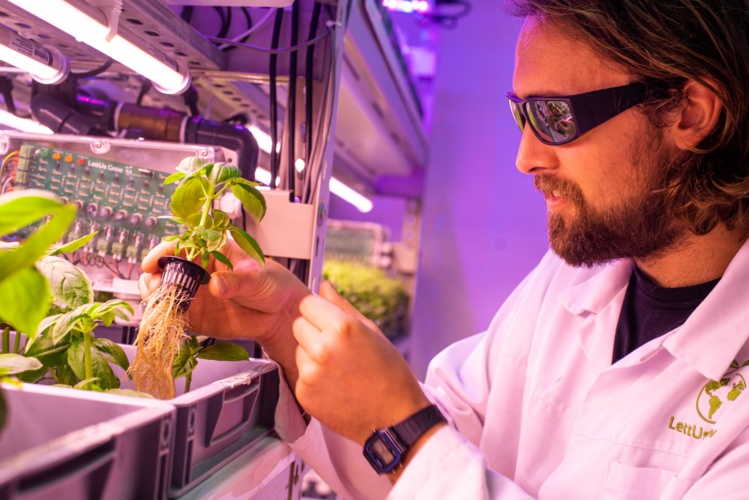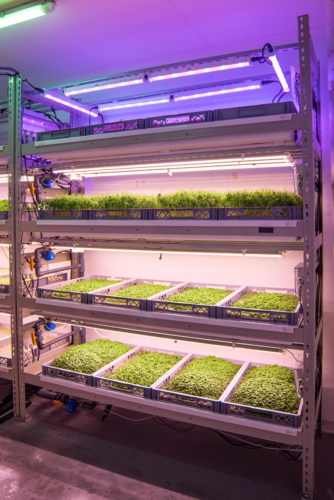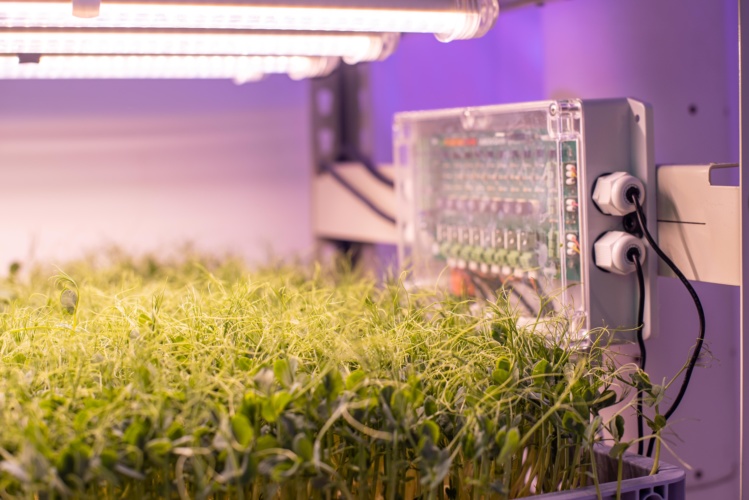
Between the UK’s EU exit and the growing threat of climate change, food security has become a headline topic. The supply lines from farm to fork that many of us take for granted can be more fragile than we think, as illustrated by recent weather events in the UK.
“At the height of the heatwave that we had last summer, (the UK) was importing lettuce by plane from California, importing around 30,000 heads a week just to keep food on our shelves,” explained Charlie Guy, managing director and co-founder of agritech startup, LettUs Grow.
Set up in 2015 while Guy was still at Bristol University, LettUs Grow is one of several emerging UK businesses focused on vertical farming, where plants and crops are grown indoors in upright stacks, typically without soil, using LED lighting, climate control and targeted nutrient delivery. Although still a relatively niche enterprise, it’s attracting plenty of attention, with grocery retailer Ocado recently announcing a £17m investment in the sector.
Green machines: sowing the seeds of farming 4.0
For its part, LettUs Grow has just secured £2.35 million in seed funding, which Guy says the company will use to scale up and invest in new products. Currently, the business has two major components: its aeroponic nutrient delivery system and an integrated farm management software platform called Ostara. According to LettUs Grow, its aeroponics equipment can boost growth rate by 70 per cent across a range of crops compared to other vertical farming methods such as hydroponics, as well as reduce water usage by 95 per cent versus traditional agriculture.
“At LettUs Grow we’ve developed two key technologies,” Guy explained. “The first is a new aeroponic method where we irrigate the crop roots with a very fine mist using a patent-pending method that we’ve developed over the last few years. It has massive benefits in terms of how scalable the technology is and controllable and optimisable it is.
“It’s all about the amount in the root zone that plants experience. Everyone knows that healthy soil has good pockets of oxygen and nutrients and is well aerated. So this is really what we’re maximising. By having no soil and an air gap you’ve got bountiful oxygen and carbon dioxide for plants to perform at their biological optimum.”

Somewhat misleadingly, LettUs Grow is primarily a technology provider rather than an actual food grower, supplying its equipment and software to farmers and entrepreneurs seeking out new opportunities. According to Guy, the return on investment of aeroponics takes just two to three years, while the more widely used hydroponics takes between four and five.
But nutrient delivery is just one part of the vertical farming picture. Advances in LED lighting, coupled with a reduction in cost, have played a key role in the sector’s boom. Rather than simply replicating sunlight, LEDs can be finely tuned to different wavelengths for various crops. Combined with carefully controlled climate conditions, LEDs and aeroponics can enhance every aspect of growth, maximising crop yields.
“All of these are effectively ways that we can optimise or tune the performance of a plant so that it’s most photosynthetically efficient and working at its optimum,” said Guy.
The second pillar of LettUs Grow is Ostara, a bespoke software platform that can monitor and control indoor growing in greenhouses as well as vertical farms. Sensors throughout the growing environment feed back to the software, which collates the data and provides crop growth analysis. On top of this, Ostara also incorporates tracing of crop history, something that Guy believes has become more important for retailers and consumers given events of recent years.
“The real importance of this was seen in 2018 with the romaine lettuce scandal in the US, where contaminated produce was on shelves and nobody knew where it had come from,” he explained.
“One of the massive benefits of indoor and controlled-environment agriculture is that we can really know where our produce has gone and what it’s experienced after it was produced and grown.”
The elephant in the room remains cost. Swapping sunshine and soil for LEDs and aeroponics may deliver a host of benefits, but is also comes at a price. The energy inputs currently required for vertical farming make it difficult to turn a profit on anything but high value herbs and leafy greens. Basil, parsley, and watercress grow quickly and sell at a premium, making them the perfect candidates for vertical farming in terms of competitiveness.
“To date we’ve grown around 60 different crops in our facility,” said Guy. “We’re mainly focused on the high-value herbs or lettuce and leafy green crops, but we’ve also grown things like carrots, radishes strawberries and a whole host of things like tobacco and propagation for trees.”

Seasonal demand sees peaks and troughs in the price of things like cress and lettuce, and carefully choreographed growing at scale could allow vertical farms to be profitable in these types of markets. Whereas traditional agriculture has been pushed to the limits of its productivity, this nascent farming method has plenty of headroom to make leaps in efficiency as it scales up and technology improves. Urban farms that supply on demand to high-end city restaurants is one business model that Guy thinks could work, but knowing your market is key.
“There’s no point growing crops that are fashionable but you don’t know where you’re going to sell them,” he said.
“We’ve been working with a company who supply 20 or so of the best restaurants in Bristol - Michelin Star quality. So quality is definitely one of the biggest selling points.”
Ultimately, the produce also has to be able to match conventional agriculture on price.
“Food grown in these systems has to be competitive with traditional methods…and we’re building tools and features into our software that will enable efficiencies in labour and energy as well,” said Guy.
One of those features is integration with renewable energy. LettUs Grow recently partnered with Octopus Energy to optimise power usage throughout the day, avoiding times of peak demand. In a controlled indoor environment, day and night can be variable concepts that reflect the vagaries of the energy market rather than the rising and setting of the sun.
“We’ve already shown around a 15 per cent reduction in energy through this,” said Guy. “And with energy being one of the biggest contributors to most crops in an indoor facility, this is pretty significant.”
As well as herbs and leafy greens, the company has identified a more niche area with potential for profit. Research sectors, including the pharmaceutical industry, often require exotic plants or novel strains of crops. The closely controlled environment of vertical farming can not only guarantee provenance, it can provide tweaks and adjustments in growing conditions to produce an abundance of different outcomes on demand.
“We’ve been working with a company testing crops that could be used for vaccine production,” Guy explained, “so there’s all sorts of novel uses where you really want that tight level of control.”
Despite the produce being endorsed by high-end restaurants and big pharma, the nature of the growing method has also brought some unexpected hurdles.
“At the moment we aren’t able to certify as organic, even though our sustainability credentials are arguably better than organic,” said Guy. “This is a bit of a sticking point, because we don’t have any soil, and without any soil it’s hard to certify that soil as organic.”
As much a philosophical problem as a technical one, the absence of soil is nonetheless preventing vertical farming from achieving the same certifications as traditionally grown food. It’s symptomatic of an industry still coming to terms with a new method and its impact. As the sector expands, these growing pains will no doubt be overcome, allowing vertical farming to play an important role in agriculture’s 21st century tech revolution.




Nanogenerator consumes CO2 to generate electricity
Whoopee, they've solved how to keep a light on but not a lot else.